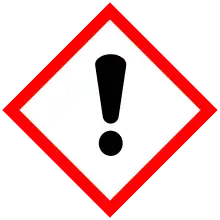 | |
| Names | |
|---|---|
| IUPAC name
Strontium oxalate | |
| Identifiers | |
3D model (JSmol) |
|
| ChemSpider | |
| ECHA InfoCard | 100.011.286 |
| EC Number |
|
PubChem CID |
|
| UNII | |
CompTox Dashboard (EPA) |
|
| |
| Properties | |
| SrC2O4 | |
| Molar mass | 175.64 g·mol−1 |
| Appearance | White powder[1] |
| Density | 2.08 g/cm3 |
| Boiling point | Decomposes above 200 °C (392 °F; 473 K) |
| Insoluble in water | |
| Hazards | |
| Occupational safety and health (OHS/OSH): | |
Main hazards |
Skin and eye irritant. Inhaling the compound irritates mucous membrane in the lungs. |
| GHS labelling: | |
 | |
| Warning | |
| H302, H312 | |
| P264, P270, P280, P301+P317, P302+P352, P317, P321, P330, P362+P364, P501 | |
| NFPA 704 (fire diamond) | |
| Safety data sheet (SDS) | |
| Related compounds | |
Related compounds |
|
Except where otherwise noted, data are given for materials in their standard state (at 25 °C [77 °F], 100 kPa).
Infobox references | |
Strontium oxalate is a compound with the chemical formula SrC2O4. Strontium oxalate can exist either in a hydrated form (SrC2O4·nH2O) or as the acidic salt of strontium oxalate (SrC2O4·mH2C2O4·nH2O).[2]
Use in pyrotechnics
With the addition of heat, strontium oxalate will decompose based on the following reaction:[3]
- SrC2O4 → SrO + CO2 + CO
Strontium oxalate is a good agent for use in pyrotechnics since it decomposes readily with the addition of heat. When it decomposes into strontium oxide, it produces a red flame color. Since this reaction produces carbon monoxide, which can undergo a further reduction with magnesium oxide, strontium oxalate is an excellent red flame color producing agent in the presence of magnesium. If it is not in the presence of magnesium, strontium carbonate has been found to be a better option to produce an even greater effect.
References
- ↑ https://pubchem.ncbi.nlm.nih.gov/compound/Strontium-oxalate
- ↑ Knaepen, E. "Preparation and Thermal Decomposition of Various Forms of Strontium Oxalate". Thermochimica Acta 284.1 (1996): 213-27.
- ↑ Kosanke, K. "Chemical Components of Fireworks Compositions". Pyrotechnic Chemistry. Whitewater, CO: Journal of Pyrotechnics, 2004. 1-11.
